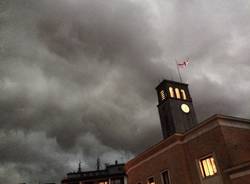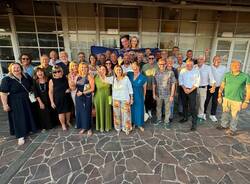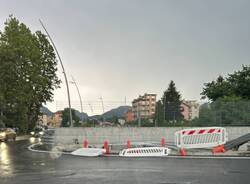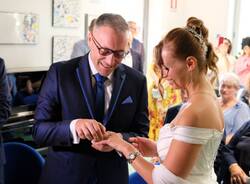The network of the Varesotto industrial museums arises: “All together to not lose our roots”
MIVA is the name of the network that unites eight important museums that narrate the story of the Varesotto industry. Maffioli: “United to be stronger and to grow”.
At a time of great difficulty such as the one that all cultural institutions are going through, creating a network is one of the possible ways to not disperse patrimonies that are the basis of entire communities. In the province of Varese, the industrial culture is the one that permitted entire generations to emancipate from poverty thanks to the spirit of entrepreneurs who were also the social motor to make entire communities grow through work.
For this reason, with the new restrictive measures to stop the contagion of coronavirus that will also close the museums, those dedicated to the industry of the Varese province territory have created a network. Thanks to the Busto Arsizio town management an “Agreement of network for the promotion and the integration of the industrial Museums of the Varese province” was written, with the Museo del Tessile e della Tradizione Industriale (Textile and Industrial Tradition Museum) as leading proponent and partner for other seven realities scattered throughout the province.
There is the Volandia park and flight museum: founded in 2010, it is the largest Italian aeronautical museum and also one of the biggest in Europe and it collects more than 100 airplanes in the former Caproni workshops. There is the Agusta museum: founded in 2002, it collects in the seat of Cascina Costa hundreds of relics, documents, drawings, photographs of characters, events and products, prototypes, models and reproductions in reduced scale of airplanes, helicopters, motorcycles and components, which remember almost a century of the Augusta company story. There is also the museo delle Industrie e del Lavoro del Saronnese (Saronnese Industries and Labour museum): founded in 1998, it illustrates the industrial story of the Saronno territory and its close connection with the Railway.
It could not miss the Museum of Motocicletta Frera: founded in 2005, it exhibits Frera motorcycles from the first productions to the last ones. There are overall more than 50 motorcycles, photos and documents of the history of Frera. Speaking of motorcycles there is the Fisogni Museum of the Stazione di Servizio: founded in Tradate in 1966, it is composed of more than 5,000 objects between gas pumps, number plates, graphics, oil cans, oilers, hydrometers, compressors, fire extinguishers and an outstanding number of vintage postcards and gadgets, each with a logo of an oil company of the beginning of the last century.
Always within the sector of industrial tradition, there is the Museum of the Pipa in Brebbia: founded in 1979, it gathers not only many thousands of pipes, but also publications made all over the world about pipes and an accurate study about the design divided into various periods; Always in the motorcycles field there is the Flaminio Bertoni Museum: founded in 2007, it is based in the park and Museum of Flight of Volandia and celebrate the figure of the great designer of cars.
The agreement was approved by the governing body of all museums and by the City Council of Busto: The City Administration of Busto is the only one present in the network since the Textile Museum is a city property and no museum belongs to public bodies. The acronym that identify the network is MIVA.
“Today a long-cultivated project finds its fulfilment and we worked for that with a strong determination, also towards the direction shown by the museum’s policy of Lombardy Region (Regione Lombardia).” comments the vice-mayor and assessor of Identity and Culture Manuela Maffiolini. “With the creation of the regional network of industrial museums we obtain two important results: we give more strength to each museum, precious expressions of a skill of our territory, and, meanwhile, we offer our province and one of its essential value, the work, a higher cultural dignity: it is a honour that our beloved Textile Museum, fascinating narrator of the greatness of Busto, is the leader.” “Our territory,” continues Maffiolini, “has been always identified for its hard work and the industrial museums are the proof, wealth of wealth and, simultaneously, of skill that, today, acquire a louder voice, thanks to the network.”
The agreement about the network between the industrial Museum is aimed to the promotion of cultural heritage linked to the industrial tradition of the Province of Varese; the rationalisation of instrumental, financial and human resources; the promotion of the relationship between Museums and territory and the increase of the fruition of the collections; the share of information, best practices and equipment among the Network bodies for the creation of common projects; the coordinated management of communication activities and visibility of each Museum and the activities of fundraising; the services of musem didactic; the update of the staff; the policy and the venture of study and research about the tradition and the history of craftsmanship and industrial work in the territory of competence.
The network does not intend to overlap the autonomous programming of individual museums but aims to strengthen the activity also through the coordinated communication of initiatives and the creation of common projects.
“One of the historical elements that characterizes the territory of the province of Varese is the development of the manufacturing industry, which has influenced the transformation of the landscape, society, economy and culture of our territories and has built communities,” underlines the President of the Province of Varese and Mayor of Busto Arsizio Emanuele Antonelli. “Those same communities, recognizing in the industrial tradition one of the fundamental traits of their identity, have given rise to the Museums of Industry and Work which today are called not only to bear witness to a glorious past, but also to be places of innovation and training at the service of the new generations. And I am particularly proud that this new reality has started from Busto and the Textile Museum: synergy is the trump card on which to bet to further enhance these treasures and consequently our identity”.
“The company is not only a treasure trove of knowledge, skills, production of value and wealth,” says Roberto Grassi, President of the Union of Industrialists of the Province of Varese. “Each company, in its own way, is also a cultural heritage and a bearer of social as well as economic values. Especially in an area like Varese, whose history and present, with all its development dynamics, are so intrinsically linked to industry. This is why the network of industrial and business museums in our province are so important. Not because they simply tell a story, but because they represent the interpretation of what we are as a community. Every time we enter one of these museums it is as if we reflect ourselves in ourselves, in who we are and what we will become. Let’s think about what lies behind every product or machine on display: dreams, effort, dedication, passion, redemption, disappointment, success, study, sacrifice. The province of Varese is the enterprise, is the industry. We therefore welcome an agreement that brings together all these experiences, creating synergies and a critical mass of resources and ideas to enhance them. A task that belongs to the institutions and companies, but also to every citizen. Let’s go into these fantastic museums, visit them, take our children with us. Let us rediscover through these caskets the culture of doing, which so markedly distinguishes us”.
At the presentation of the initiative today at the Textile Museum participated in addition to the Deputy Mayor Maffioli, Marco Reguzzoni, President of Volandia, with Delia Durione representing the Bertoni Museum, and Marco Mocchetti for the Fisogni Museum. “Our presence is even more significant for the moment we are living,” says Reguzzoni. “The companies of which these museums are an expression have never stopped, not even during the war, and so our museums will not stop either, we continue to work together to overcome this situation and start again stronger than before”. “The Fisogni museum has the largest collection in the world on the theme of service stations,” noted Mocchetti. “We are a small company, it is important for us to network in order to make ourselves known and not to risk being without an audience, the network can ensure that our heritage is not lost.
Translated by Andrei Aldea and Michela Villa
Reviewed by Prof. Robert Clarke
La community di VareseNews
Loro ne fanno già parte
Ultimi commenti
Emanuele Zanetti su Motociclista di Ferno ucciso da un orso in Romania
GrandeFratello su Superate le 700 firme per la petizione sul recupero del Grand Hotel Campo dei Fiori di Varese
Felice su Motociclista di Ferno ucciso da un orso in Romania
Stefano64 su Neil Young torna dopo l'enorme successo di Harvest: ma non è il disco che tutti si aspettano
Alessandro Zanzi su Superate le 700 firme per la petizione sul recupero del Grand Hotel Campo dei Fiori di Varese
Felice su La bibliocabina, la panchina e il cane che fa pipì. A Fagnano Olona scoppia la polemica
















Accedi o registrati per commentare questo articolo.
L'email è richiesta ma non verrà mostrata ai visitatori. Il contenuto di questo commento esprime il pensiero dell'autore e non rappresenta la linea editoriale di VareseNews.it, che rimane autonoma e indipendente. I messaggi inclusi nei commenti non sono testi giornalistici, ma post inviati dai singoli lettori che possono essere automaticamente pubblicati senza filtro preventivo. I commenti che includano uno o più link a siti esterni verranno rimossi in automatico dal sistema.